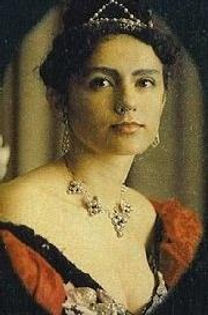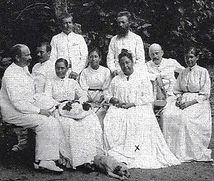
Rabaul Mask Festival
Bainings Fire Dance & Duke of York Islands Along with other New Guinea Island Experiences
Rabaul Mask Festival & Fire Dance - Duke of York Islands
Plus New Ireland Extension
Mon 7th to Mon 14th July 2025
8 Days / 7 Nights Tour
AUD5,900 p.p Twin Share
Single Supplement AUD590
Include New Ireland to 17th July
11 Days / 10 Nights Tour
AUD7,490 p.p Twin Share
Single Supplement AUD590
The New Guinea Island of New Britain offers a wonderland of cultural expression and historical intrigue set against the most dramatic of natural landscapes. Attend the East New Britain Mask Festival where ancient animist beliefs are celebrated in enthralling performances of music and dance. Relax on the idyllic Duke of York Islands where the seas abound with wild dolphins, dugongs and stunning scenery. Climb Mount Tavurvur, the active stratovolcano, that steams menacingly above the lunar like landscape of Rabaul Township. Learn about the key roles these islands played during the 2 world wars and the colonial characters that shaped its status as a hub of economic advancement. Add tours of New Ireland, Bougainville or Kimbe Bay in West New Britain to your itinerary for a complete adventure of the New Guinea Islands.
INCLUSIONS : Tour Package includes All Meals, Accommodation, Guides, Sightseeing, Entry Fees to all activities, Porterage, Transfers, Land & water Transport & Experienced Australian Tour Leader and 2 Domestic Air Flights.
The New Ireland extension is included in the 11 Day Itinerary below
The New Ireland extension is included in the 11 Day Itinerary below
NEW IRELAND is renowned internationally for its unique Malagan carvings and traditional culture. Divers know the area for its variety including numerous wrecks. Surf breaks abound with uncrowded waves. The fish are plentiful and the entire length of the island is easily accessed by a sealed road that runs for it's entire length.
BOUGAINVILLE is one of the most naturally beautiful islands in the South Pacific. It's future and desire to become an independent country is one of the most anticipated developments in the region. Soak up the political intrigue along with the jungle fringed beaches and waterfall draped mountains. Unique customs displayed for the curious.
Kimbe Bay in WEST NEW BRITAIN is fringed by a number of active volcanic mountains. Dive magnificent volcanic caves draped in staghorn coral and reef drop-offs from the dive centre at Walindi Plantation Resort. If you’re keen to keep your head above water, the fishing, trekking, and hot springs are excellent diversions in this area, meaning non-divers can also enjoy the superb natural surroundings.








Extend your holiday with more days spent on any combination of these New Guinea Island destinations.
Flynns Tours is the only Tour operator serving PNG that includes the cost of all domestic airfares in your Package.
* For this tour a price cap of AUD900 included in the total package price should cover the cost of the 2 Domestic Flights. Following consultation any excess to this price cap will be billed to the client.Papua New Guinea is a developing country with a mountainous mainland surrounded by many remote islands. The regional centres are for the most part un-connected by road. Travellers normally book with only 2 nationally owned airlines that provide the only reliable air service. Airfares are expensive and without experience they are difficult for outsiders, even travel agents to book without the risking the smooth running of this Small Group Tour of PNG. Flynn's Tours experienced staff remove the risk and with all tour participants booked in a group booking we can provide the lowest prices possible and manage your bookings for you and allow you to enjoy your holiday without frustration and disappointment !




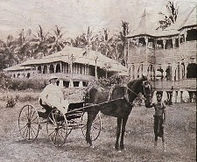
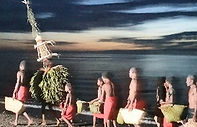
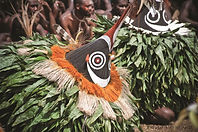







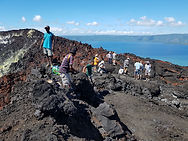


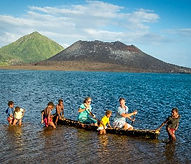
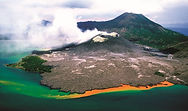
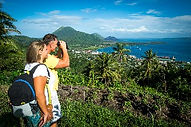












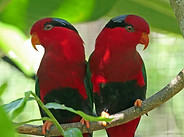


Day By Day Itinerary includes New Ireland Extension
Day 1 - Kokopo - East New Britain
International flights arriving into Port Moresby will enable us to enjoy an scenic drive up to the Varirata National Park’s forests on the lookout for a Birds of Paradise and enjoy the spectacular views of Port Moresby, it's scenic harbour and surrounding mountainous landscape. We view the ruggedly beautiful views of the Laloki River as we drive further up to the Sogeri Plateau and the foothills of the Owen Stanley Ranges to the start of the Kokoda Track at Ower's Corner. On the return journey we briefly visit the Bomana War Cemetery where those who died in the fighting in Papua New Guinea are buried, their graves brought in by the Australian Army Graves Service from burial grounds in the areas where the fighting had taken place. We return to our boutique hotel accommodation where you can enjoy a dip in the pool before consuming a delicious evening meal
Sanctuary Hotel Resort and Spa - Port Moresby or similar
Day 2 - Kokopo & Gazelle Peninsula - East New Britain
This morning we transit to Jacksons Airport for the flight to Tokua Airport - Kokopo/Rabaul in East New Britain.
Upon arrival you will check into your hotel/resort accommodation before we depart on a tour of the Gazelle Peninsula to observe cocoa, copra and palm oil cultivation undertaken in the rich volcanic soil, noting the area’s significant contribution to the national economy. In Kokopo we will visit the Agmark cocoa fermentary where the method of processing cocoa for export to the world’s chocolate makers is explained by the fermentary management. Kokopo, named Herbertshohe in the earliest colonial period, was from 1884 to 1910 the capital of the German New Guinea colonial empire. You will visit the historic German cemetery, the cathedral at Vunapope Catholic mission and the Kokopo Lookout. View the beachside landing site at Kabakaul from where Australian military forces advanced in 1914 to capture the German wireless station at Bita Paka. This battle was Australia’s first major military engagement of the First World War. Bita Paka War Cemetary is now the resting place of over one thousand Australian and Allied soldiers who met their fate during World War 2, when “Fortress Rabaul” became the South Pacific headquarters and staging post for the Japanese Imperial Forces. It was occupied by 100,000 Japanese soldiers. Your tour will include a visit to the Kokopo market, one of the biggest in Papua New Guinea.
Relax beachside or poolside at your resort accommodation.
Rapopo Plantation Resort – Kokopo or similar
Day 3 - Kinavai and Mask Festival - Kokopo - East New Britain
Gather at dawn on the Kokopo foreshore for the Kinavai, which signifies the landing of the Tolai people in East New Britain several hundred years ago and marks the official opening of the Mask Festival. The Kinavai represented with the arrival of the Tumbuan in their traditional masks, alighting from canoes paddled in the pre-dawn darkness from the neighbouring Matupit island. Dancing to the primal sounds of chanting and kundu drums, the revered ancestral spirits arise to welcome dancers wearing traditional masks from all over Papua New Guinea. Return to the hotel in Kokopo to refresh and then travel a short distance to the festival grounds for the opening day of the Mask Festival. Among many highlights, the standouts include the Kusare warriors from Kandrian on the South coast of New Britain’s western province and the immediately recognisable Malagan Mask Dancers from New Ireland. From closer to home, the tall Tubuans from the Pomio district, the Tolai whip dancers along with neighbouring New Ireland’s renowned Malagan mask men all add to the colour and movement. Return to your accommodation for a refreshing swim and dinner..
Rapopo Plantation Resort – Kokopo or similar
Day 4 - Mask Festival and Fire Dance - Kokopo - East New Britain
Spend the early morning snorkeling the house reef at Rapopo Resort before the second day of the Rabaul Mask Festival kicks off. We return to the festival grounds this morning to continue to enjoy a VIP viewing of the days cultural performances. During the day we can take a quiet break from the festival and visit the Kokopo Museum which is located near the Festival grounds. The Museum houses an impressive range of war relics along with an informative display of colonial, military and natural history. We enjoy a hearty Asian style lunch at the Ralum Country Club enjoying stunning ocean views over Blanche Bay. The bay is named after HMS Blanche, which surveyed the bay under the command of Captain Cortland Simpson in 1872. Standing on “Emma’s Steps” we hear stories about the achievements and exploits of Queen Emma Coe. She was a Polynesian Princess and daughter of an American sailor and Samoan mother who in the late 19th century brought commerce to East New Britain, through her savvy business sense and huge land holdings, upon which she grew an abundance of copra and cocoa. The steps are 140 years old, built in 1882 to grace Queen Emma’s famous bungalow Gunantambu. They were climbed by Governors, Ambassadors and Officers representing German Kaiser, American President and kings of England, France and other European nations along with assorted bishops and world-renowned scientists, explorers, anthropologists and adventurers. Gunantambu gatherings were famous throughout the South Seas. Returning to the festival grounds after lunch, you will continue to enjoy a VIP viewing of the days performances. Return to your accommodation for a refreshing swim and dinner.
After dinner, you will be transferred to Gaulim Village in the Bainings area. This evenings spectacular Bainings Fire Dance is performed only by men from the Bainings clans, where they immerse themselves into the flames of the fire and escape completely unharmed. This amazing ritual is not performed anywhere else in the world. One of few cultures in Papua New Guinea who do not use the Kundu drum as their rhythmic percussion instruments, the Bainings clan instead use bamboo, and the sound is just as unique as the fire dance itself. After the performance, return back to your hotel.
Rapopo Plantation Resort – Kokopo or similar
Day 5 – Duke of York Islands
Early this morning we travel by boat across the St. Georges Channel to the Duke of York Islands and their picturesque lagoons. This idyllic paradise is made up of a dozen or so islands set among a mesmerizingly, forever changing backdrop of colourful tropical landscapes. The natural beauty is interspersed with scenes of village life as the happy villagers go about living beside the tranquil waters they share with an abundance of marine life. A welcoming host will ensure that your traditional village style accommodation is comfortable, secure and restful as where we are based is a largely uninhabited island. We will dine on plentiful amounts of delicious and freshly harvested fruit, vegetables and fish. We will visit Kabakon “the garden” Island , Pangpang “sand” Island and enjoy a seafood BBQ meal.
In 1902, the 25-year-old German health reformer, August Engelhardt, who practiced sun worship and a strict coconut diet, retreated from Bavarian university life to Kabakon Island, which he purchased from his mother country with an inheritance. The first few years were idyllic. Engelhardt established a coconut plantation and called his followers to join him in this brave new world. They called themselves Sonnenorden and practised sun worship and nudity and lived off coconuts. But it didn’t last. The alien living conditions took their toll and several died. Others turned their back on him. Engelhardt, known by the local islanders as Mr Coconut, was eventually left alone, gripped by malaria and went insane. He died on the island aged 46 in 1919. Be enthralled with the playful dolphins and mysterious dugongs. Relax whilst birdwatching on the many enchanting jungle trails or beachcomb at your leisure. Learn from hands-on agricultural demonstrations of cocoa, coconut and native garden cultivation and harvesting.
Following our frolic amongst the beautiful Duke of York Islands we return to New Britain Island and drive the scenic coastal route to Rabaul passing by the "pop-up" volcano Vulcan. We explore the underground Japanese Hospital tunnels dating from World War Two and the tranquil memorial gardens at the Chinese cemetery where your tour leader, John Gannan, will explain aspects of the historically long association the Chinese have had with East New Britain, along with the many other people and cultures that have shaped this part of New Britain Island. We climb around the large barges of the Japanese Imperial forces that are still housed in even larger tunnels hewn into the soft volcanic cliff faces on the shores of Blanche Bay. Tonight we relax in idyllic surroundings at Kulau Beach Lodge, Kabakada Village in Talia Bay on the North Coast Road. before dinner enjoy a swim and snorkel the house reef which is home to many varied species of coral and marine life.
Kulau Lodge Beach Resort - Rabaul
Day 6 – A Rabaul Ramble amongst Volcanoes & War History
This morning we travel to Simpsons Harbour to enjoy spectacular views on an early morning climb of the active volcano, Mt Tavurvur. While the climb is challenging, it’s not beyond most people’s capability to reach the top. Flynn’s Tours has had an octogenarian comfortably complete the ascent. You can take in further views of Rabaul’s picturesque harbour and its six volcanoes from the Vulcanological Observatory on Tunnel Hill. An informative talk delivered by an onsite vulcanologist will enlighten you of the workings of volcanoes, lava, magma and related geological, geophysical and geochemical phenomena. The Rabaul caldera was created about 1400 years ago with an explosion which erupted 11 cubic kilometres of rock. This massive outpouring of gas, lava, rocks and ash produced the largest volcanic dry fog in recorded history. A mysterious cloud that blocked sunlight for 12 to 18 months over Europe, China and the Middle East in 536 AD is linked to this mighty eruption. You will tour the area of current volcano activity and clamber around Mount Tavurvur. See the hot springs, sulphurous steam points and the megapode egg hunters who burrow metres into the black sand emerging with the prized eggs. Megapodes do not incubate their eggs with their body heat as other birds do, but bury them. Their eggs are unique in having a large yolk, making up 50-70% of the egg weight. The birds here are burrow-nesters which use geothermal heat. Some species vary their incubation strategy, such as building mounds to bury them in, depending on the local environment. We travel around the remains of old Rabaul town (including its airport) which resembles a lunar landscape, following its burial in volcanic ash during the dramatic eruptions of 1994. Prior to the burial of Rabaul town it was revered as “the Pearl of the South Pacific”. East New Britain’s commercial hub has been re-established in a modernised Kokopo over the past 30 years. Rabaul was also badly damaged during an earlier eruption on 6 June 1937, five years before the occupation by Japanese military. We visit Matupit Island whose people and settlement survived the worst of the 1994 volcanic eruption despite their location immediately beneath it. Visit old Rabaul Township and see the resulting destruction caused by the 1994 volcanic explosions. Discover the pre-European settlement history and recent colonial occupations by German, Japanese and Australian administrations at the New Guinea Club and Rabaul Historical Display. Explore the Japanese military command bunker of Admiral Yamamoto where maps of the surrounding area are etched into the bunkers ceiling at head height. We travel back through Rabaul where we will visit the underground Japanese Hospital tunnels dating from World War Two and the tranquil memorial gardens at the Chinese cemetery where your tour leader, John Gannan, will explain aspects of the historically long association the Chinese have had with East New Britain, along with the many other people and cultures that have shaped this part of New Britain Island. We climb around the large barges of the Japanese Imperial forces that are still housed in even larger tunnels hewn into the soft volcanic cliff faces on the shores of Blanche Bay. Tonight we relax in idyllic surroundings at Kulau Beach Lodge, Kabakada Village in Talia Bay on the North Coast Road.
Kulau Lodge Beach Resort - Rabaul
Day 7 – Options A or B – Sunday 13th July 2025
OPTION A - For participants ending their tour with a flight from Tokua Airport / Rabaul to Port Moresby for same day or Monday 14th July international departures from Port Moresby :
Enjoy a scenic Drive to Tokua Airport for a Sunday morning departure on PX 203 - 11.50 am flight from Tokua Airport to Port Moresby arriving at 1.30 pm to transfer to international departures or transit to Hotel accommodation to stay overnight for flight departures on Day 8 on Monday July 14th 2025.
OPTION A Accommodation : Sanctuary Hotel for Monday Departures
OPTION B - New Britain's History, Customs & Foods Immersement
Today we will have the customary shell money concept explained in detail with an opportunity to make your own string of shell money. Early missionaries and travellers to New Britain found it to be the only area in the Pacific region they had come across where the locals had a true money currency of a standard value. The Europeans were intrigued by the local monetary system and the way in which Tambu was intricately woven into the very texture of social life. It still plays its role in Tolai society today, maintaining its cultural significance, particularly as part of the bride price or gift giving to the father of the would be bride. It is exchanged to mark births, marriages and deaths. The standard unit of currency is the 'pokono' or fathom (a grown man's arm span). Be fascinated by stories from the Tubuan Society of the local Tolai people who have strict laws and taboos. Learn of the Ingiet stone carvings associated with the powerful Ingiet sorcerers and the secret men’s society, outlawed by the German administration in 1905.
It was from Wesleyan Methodist Mission in Fiji that the first mission team were sent to New Britain Island in 1875. Fijian missionaries proselytization legacy and martyrdom is today honored in Kabakada village, next to the Kulau Lodge Beach Resort. A memorial monument was erected on top of the buried remains of the four slain martyrs on Vunela hilltop on 15 August 1975, the one hundredth year anniversary of the arrival of the Fijian missionaries in the New Guinea islands. The burial site now known as the Fijian Cemetery holds 41 graves which are now part of the Vunela historical tourism site. Six married, and three single, men were chosen to work under the supervision of Reverand George Brown, an experienced missionary, who had served in Samoa. Within three years, most of them were dead. A powerful New Britain pagan chief massacred three of them, and some died of malaria. But, there was no shortage of Fijians, who were ready to take their place.
For dinner tonight we will taste Aigir is a traditional cuisine of the Tolai people of East New Britain Province in Papua New Guinea. It's been a main dish for generations of the Tolai people and is prepared on special occasions and family gatherings. The method of cooking Aigir which is made by heating hot stones to boil liquid coconut and pure coconut will be demonstrated. The dish is widely accepted as one of the finest dishes. Aigir works by heating the liquid with hot stones. To make Tolai aigir, you peel kaukau and bananas, cut them in half, and add aibika, salt, sliced onion, and tomatoes to heated coconut oil. Aigir is consumed with meats prepared in the traditional method of cooking known as Mumu which is regarded as the national dish of Papua New Guinea. It is composed of pork or chicken, sweet potato, taro, plantains, with leafy vegetables. Mumu is an example of a balanced dish composed of the two bases, crops (including starch) and meat. The dish is named after the earth oven used to cook it and will also be demonstrated.
Kulau Lodge Beach Resort
Day 8 & 9 – New Ireland - Scenically Spectacular
This morning we depart from Rabaul on a confortably fitted out motor boat for a safe journey across the St. Georges Channel offering a different view of Rabaul’s volcanoes and also the Duke of York Islands. We arrive on the western coast of New Ireland near the settlement of Namatanai which is on the opposing side of the island province, a few kilometres away.
We arrive for lunch at the well appointed Rubio Plantation Retreat, a well regarded surfing site where the surfable waves roll in from October to April.
Soak up the laid back atmosphere of a this beautiful New Ireland beach and enjoy some bird watching later in the afternoon. Fall asleep to the sound of breaking waves as you rest up for your next day of experiences travelling to Kavieng.
Departing the plantation retreat we travel down the Boluminski Highway, one of the most spectacularly picturesque roads in Papua New Guinea. We explore the Pam Waterfall located just by the roadside with easy access. We trek along the jungle paths of the Lelet Plateau enjoying panoramic views out to Tabar Island. The Lelet Plateau in Central New Ireland, embodies the harmonious coexistence of agriculture, communal activities, and cultural traditions. The fertile land, coupled with the strong community bonds, forms the essence of life in these villages, creating a vibrant and self-sustaining ecosystem. The fertile land supports a variety of crops, including sweet potatoes, taro, yams, bananas, and a range of other vegetables. Farmers employ traditional techniques passed down through generations, cultivating small plots using manual tools. They rely on the abundant rainfall and favorable climate to nurture their crops. Farming activities are often communal, with villagers working together during planting and harvesting seasons, fostering a sense of community and cooperation. In addition to horticulture, the Lelet Plateau villagers engage in various activities to support their livelihoods. Livestock rearing, such as raising pigs and poultry, is common, providing a source of food, trade, and ceremonial significance.
We return to the main road to chill out with the locals, floating on rubber tubes down the river that runs through Dalum Village where we enjoy lunch on the beach in a truly idyllic setting.
We will visit the Malagan Mask Gallery in the village of Langenia where master carver, Fabian Paino works with his team of carvers. The most famous cultural system of New Ireland is "Malagan", a Nalik word for an ancient and revered set of practices and ceremonies practised throughout much of the main island. The Malagan masks have a symbolic meaning as the dead must be remembered through the masks and ceremonies. They are the practical means of capturing the spirits of recent dead relatives or clan members. During the colonial era, significant quantities of Malagan masks were collected by European administrators and can be seen in museums all over Europe.
Heading down the Boluminski Highway edging closer to Kavieng we visit the village of Laraibina, famous for it's Eels, a unique species of freshwater eels found in the rivers and streams of the New Ireland province in Papua New Guinea. These eels possess a distinct pattern of vibrant colors, including shades of blue, green, and yellow, which make them visually striking. They are known for their elusive nature and are considered an important cultural symbol in the region, representing strength and resilience in local folklore and traditions. Arriving in Kavieng we take a spin around this laid back town that is the regional headquarters for New Ireland Province, checking out the local market along the way to our accommodation.
Day 8 - Rubio Plantation Retreat
Day 9 - Kavieng Village Resort or similar
Day 10– Culture & Nature in National Capital - Wed 16th July 2025
This morning we catch the flight from Kavieng to Port Moresby
We visit the Papua New Guinea National Museum and Art Gallery which is the “spiritual house” for the rich natural, cultural and contemporary heritage of the country. The museum draws on well over 30,000 anthropological collections, more than 25,000 archaeological collections, more than 18,000 natural science collections, more than 20,000 war relics and more than 7000 contemporary art collections for its displays. We take a brief viewing of the National Parliament of Papua New Guinea, a building that blends old and new and which combines modern architecture with ancient design.
we will also visit the Port Moresby Nature Park. Spread over 30 acres the park is home to over 250 native animals and birds along with hundreds of plant species, many of which are rarely seen outside of PNG. The Nature Park has won a number of international awards for its works.
Sanctuary Hotel Resort and Spa - Port Moresby or similar
Day 11 – Port Moresby to Home Country - Thurs 17th July 2025
Today you can fly home with direct Air Niugini flights to Brisbane , Cairns, Sydney, Singapore & Manila. Travellers flying to Brisbane can depart from Jackson's Airport in Port Moresby on a Qantas flight at 1.35 pm.
A range of international carriers provide flights to many other destinations.

Did you know?
The Mask Festival is the only festival of its kind in Papua New Guinea. Together with their amazing costumes, groups from all across the islands gather in the coastal town of Kokopo to showcase their elaborate ancestral and spirit masks whilst performing ritual dances, each style forging the unique cultural identity of a tribe.
Witness the 'Kinavai' opening ceremony at dawn, as the arrival of ancestral spirits are welcomed to chants and the beating of kundu drums by elders and initiated young men on canoes.
Experience the spectacular Baining Fire Dance from the Tolai’s of the mainland of East New Britain Province, where in this night-time traditional dance, initiated young men perform harrowing dances through blazing fires amidst evocative chanting by their elders. Join us as we experience one of the most fascinating festivals Papua New Guinea has to offer.
In 1902, the 25-year-old German health reformer, August Engelhardt, who practiced sun worship and a strict coconut diet, retreated from Bavarian university life to Kabakon Island in the Duke of York Islands, which he purchased from his mother country with an inheritance. The first few years were idyllic. Engelhardt established a coconut plantation and called his followers to join him in this brave new world. They called themselves Sonnenorden and practised sun worship and nudity and lived off coconuts. But it didn’t last. The alien living conditions took their toll and several died. Others turned their back on him. Engelhardt, known by the local islanders as Mr Coconut, was eventually left alone, gripped by malaria and went insane. He died on the island aged 46 in 1919.
Queen Emma Coe was a Polynesian Princess and daughter of an American sailor and Samoan mother who in the late 19th century brought commerce to East New Britain, through her savvy business sense and huge land holdings, upon which she grew an abundance of copra and cocoa. The steps are 140 years old, built in 1882 to grace Queen Emma’s famous bungalow Gunantambu. They were climbed by Governors, Ambassadors and Officers representing German Kaiser, American President and kings of England, France and other European nations along with assorted bishops and world-renowned scientists, explorers, anthropologists and adventurers. Gunantambu gatherings were famous throughout the South Seas.
The Tubuan Society of the local Tolai people who have strict laws and taboos.
Learn of the Ingiet stone carvings associated with the powerful Ingiet sorcerers and the secret men’s society, outlawed by the German administration in 1905. Early missionaries and travellers to New Britain found it to be the only area in the Pacific region they had come across where the locals had a true money currency of a standard value. The Europeans were intrigued by the local monetary system and the way in which Tambu was intricately woven into the very texture of social life. It still plays its role in Tolai society today, maintaining its cultural significance, particularly as part of the bride price or gift giving to the father of the would be bride.
The Rabaul Caldera was created about 1400 years ago with an explosion which erupted 11 cubic kilometres of rock. This massive outpouring of gas, lava, rocks and ash produced the largest volcanic dry fog in recorded history. A mysterious cloud that blocked sunlight for 12 to 18 months over Europe, China and the Middle East in 536 AD is linked to this mighty eruption.
The Marquis de Ray, whose real name was Charles Guillain, was a French adventurer who attempted to establish a colony in the New Ireland Province of Papua New Guinea in the late 19th century.
Born in France in 1825, de Ray harbored ambitions of founding a utopian settlement in the Pacific.In 1878, de Ray acquired a large tract of land in New Ireland, which he named "Franceville." He proclaimed himself the Marquis de Ray and began recruiting French settlers to join his colony. Promising fertile land and a prosperous future, de Ray managed to attract around 200 individuals to embark on this venture.
However, the expedition turned into a disaster. The settlers faced numerous hardships, including disease, scarcity of resources, and conflicts with local indigenous populations. The dream of a flourishing French colony quickly crumbled, and de Ray's leadership was called into question.
As conditions worsened, some settlers managed to escape the island, and others perished. Eventually, de Ray was arrested and brought back to France to face charges of fraud and deception. He was sentenced to imprisonment and died in 1895.
The ill-fated endeavor of the Marquis de Ray in New Ireland Province serves as a cautionary tale of colonial ambitions gone awry. It highlights the challenges and complexities involved in establishing new settlements in unfamiliar territories, particularly when undertaken without adequate planning, resources, and respect for the local population
